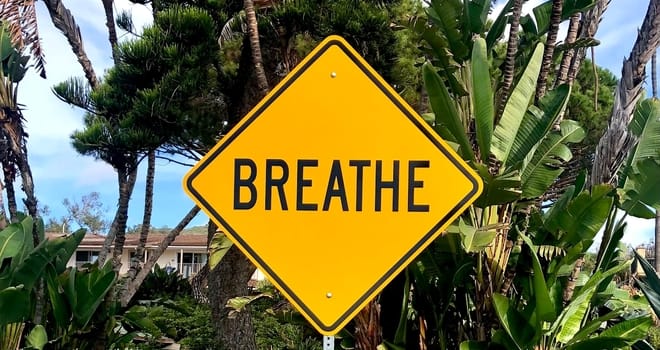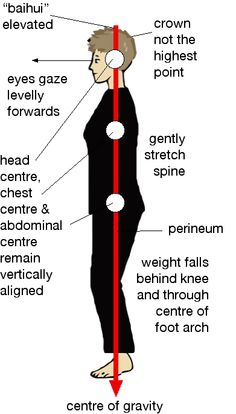Take any tai chi class, the good, the bad, or the ugly, and you will see a continual focus on improving how upright and balanced a person is. All quintessential tai chi images, regardless of style, show a beautifully erect and elongated tai chi posture. With all the argued and debated differences between the different styles, why is this a shared and important focus?
Correct tai chi posture is obtained by using an upright stance with a focus on elongating the spine from the tailbone through the top of the head. Physical benefits include improved balance, depth of bending, freeness of joints, flow of blood, and increased energy. Studies have also reported health benefits including improved mood, cognition, and pain relief.
So, why do we spend so much time correcting posture and why is the western world waking up to posture’s importance? While posture alignment in tai chi has always been a foundational focus, the reasons behind why it is a focus have not always been clear. With the advent of integrated fitness regimes and huge numbers of people suffering from back pain and sciatica, posture has finally gained its rightful position (pun intended) of importance in EVERYTHING that we do.
Here are some incredibly sad statistics compiled on The Gokhale Method website:
- 90% of adults experience back pain at some point in their lives.
- This year, 50% of working Americans will experience back pain.
- Back pain is now the leading cause of disability in people under 45 years old.
- By age 15, more than 60% of all adolescents have experienced back and/or neck pain.
This essay is about the benefits of correcting posture but for those of you that have back pain or are serious about experiencing the benefits from good posture, Gokhale’s book: 8 Steps to a Pain Free Back (ad) is unparalleled. She debunks ideas that weight, height, or bending cause back pain by sharing research on world populations where back pain does not exist. Plus, I am a big advocate of her work because it parallels tai chi theory. She does not focus on posture for posture’s sake by filling your time with exercises. She embeds changes into your daily routines. This book was instrumental in how I eliminated my own back pain.
The Benefits of Good Tai Chi Posture
Maintaining good posture is hard work! It takes focus throughout the day and awareness while sitting, lying down, or standing until good posture becomes an ingrained habit. Here are some primary reasons why it is worth your time.
Improved Alertness
Dr. Mladen Golubic, with Cleveland Clinic’s Wellness Institute, states that:
“When you slump, you have reduced your capacity to inhale properly, to inhale through your diaphragmatic breathing rather than just expanding the chest. That could lead to feeling tired and exhausted and feeling sleepy.”
Dr. Mladen Golubic
Improved Cognition
Improved tai chi posture means an increase in oxygen throughout the day and during sleep. Try to fill a crushed balloon. We also still operate under the old ideas that the brain is just in the head. The brain and the spinal column are one integrated system sharing all of the nerves, fluid and synapsis to power our body, think, organize our movements, and manage the processes of our organs. When we start to think about our brain being our spine, bad posture is bad for business.

Increased Power
Yes, ego, pull up a chair. That deadlift you were attempting, that running distance that is just out of reach, that perfect punch, is just one posture correction away. Your power and efficiency is determined by your posture. Secondly, that injury you are nursing or trying to avoid can be directly related to posture. An article by Jeff Kunland on BreakingMuscle.com captures the idea really well.
“Positioning in exercise is critical to force output, energy conservation, and safety. An athlete in a good position is resilient and tends to remain injury free. The body is meant to move large loads and have great endurance. Poor positioning and posture not only require additional energy but also strain the body in unnatural ways and directly correlates to higher injury rates.”
Jeff Kunland
Relieve Pain
Let me think this through… So you’re telling me that whoever invented the body put all of the main nerves and control for nerves endings in a tube along the back? That they put hard parts (vertebrae) to protect them and cushions (discs) between the hard parts? And if I bend this tube I crimp the nerves and get pain? Hum… Straighten the tube. Elongate the tube. Get the pressure off of the soft parts so it can heal.
Back to BreakingMuscle with another great quote:
“If you have poor posture with shoulders forward, a curve in your spine, and collapsed hips, your body is literally healing the micro-tears and micro-trauma into this poor position. You are actually healing in a shortened muscular state that remains static, slowly solidifying the new connections your body is making.”
I would add that the process works the same in reverse. Consistent work on your tai chi posture heals micro-trauma into good positions.

Improved Breathing
The sole purpose of the lungs is to bring in fresh oxygen and carry away carbon dioxide and used gases. However, the lungs have no way of functioning on their own. They are basically empty sacs which are glued to the interior of the rib cage. Their behavior is dependent on our breathing an d the expansion and compression of the ribs and the diaphragm. The rib bones rotate as the lungs fill and empty while the diaphragm expands down. Now picture a person bent forward. How much is this mechanical process impaired? Back to points 1 & 2 on cognition, how do you think the oxygen amount is affected? If you are interested, combining ways to improve your posture and deepen your breath can dramatically improve your results.
Better Mood
We accomplish more based on our outlook on life. But can that outlook be influenced by physical changes? We know the answer is a resounding yes based on work by Richard Wiseman (See our “as if” happiness post)
Research has also been carried out specific to posture. The department of Health Education carried out several experiments to test the effects of posture on energy level and positive and negative thoughts. Participants felt more energetic, happier and positive when upright and dynamic. Participants who slouched reported feeling sad, lonely and isolated.
Reduced Stress
Mental health is also coming around to this idea that posture predicts mental and emotional states. Imagine a proud person. Now, imagine a depressed person. Our internal state is directly reflected in our external posture. It used to be thought that the posture was the result of the emotional state. While this still may be true, the opposite is also found to be true. Creating a great posture purposefully can brighten your state of mind. And tai chi’s focus on posture has definitely influenced successful outcomes from studies using tai chi to reduce stress.
This from a neat article in the Huffington Post : “Sit Up Straight!” The Mental Health Benefits of Good Posture
“…the researchers theorize that as the brain receives muscular and hormonal signals with information about bodily posture, it then translates those signals into emotions. Think about it like this: “If I’m feeling sad and stressed, I am more likely to sit in a slumped position. And if I’m sitting in a slumped position, I am more likely to be sad and stressed.”
What is Good Posture?
When you have good posture sitting or standing you should be as tall as possible. Standing posture means your ears should be in line with your shoulders, in line with your hips, and over top of your knees and ankles. You should feel tall and stand neutral shoulders, not letting them roll forward REWORD

The importance of posture is now universally accepted.
The importance of posture is now known. So why do we still have statistics like the ones above? I feel that suggestions that are made on how to improve posture focus on a specific outcome or problem. For example, you could learn how to improve your posture to lift more weight or to reduce back pain while sitting at work. Articles and research have traditionally made suggestions to affect a certain change or outcome.
How is Tai Chi’s focus on posture different?
One studies tai chi as if you are in a laboratory or kitchen. Tai chi is an out-of-the-box exercise where you learn how to act or think differently with the intended goal to improve your life. This is different from the traditional suggestions. To bring the point home, the equivalent would be if you were told “improve your tai chi posture so that your form looks better. There you go. Now you look pretty.” We care about the form but our greater goal is to understand the benefits we are receiving during class or practice and translating them to the movements we perform every day.
We work to maintain great posture for a 60-120 minute class, reap the benefits, feel great, and then go home and try to emulate the posture in our natural environment. To see the relationship between tai chi posture and philosophy, look into the six harmonies.
Resources
- 8 Steps to a Pain Free Back (ad)
- How You’re Sabotaging Your Posture and Your Time in the Gym
- Burning Question: Why Sit Up Straight?
- How to Unlock Your Athletic Potential Through Good Posture
- 10 Proven Benefits of Good Posture
- How Bad Posture Can Affect Your Attitude
- Research on posture yields insight into treating depression
- Want to Feel, Look Better? Improve Your Posture



